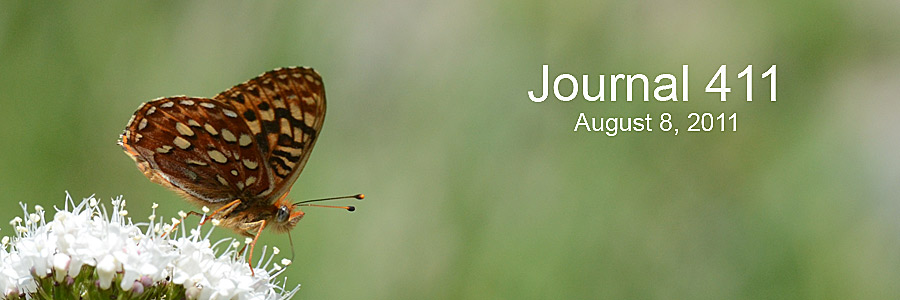
BUTTERFLY SEASON FLUTTERING AWAY
For all intents and purposes, the butterfly season is almost over. By now the last generations of all species have been born, and many are already in their hibernation stage. All that remains are the adults that are living out their short lives, or those that are fattening up for their winter hibernation. Species around Nanoose Bay that are living out their lives for the remainder of August and into September include Woodland Skippers, Common Woodnymph, Cabbage White, Pine White, Painted Ladies, Purplish Coppers, and Gray Hairstreaks. In other areas there will also be Common Ringlets, Western Branded Skippers, and the occasional late Cedar Hairstreak. Species that are preparing for winter hibernation include Mourning Cloak, comma species, and possibly Red Admiral. However, they're usually fairly scarce, and I don't expect much time in the field as I have to tend to some orthopedic issues. Of course, the added complication has been the forest closure which has curtailed any high elevation visits like Mt. Cokely. With that in mind, I decided to have two last flings - Mt. Washington on July 17 and Whistler the next day.
WASHINGTON WANDERING
July 17 was another splendid sunny day. I had no targets or projects in mind so my intention was just to have a relaxing day enjoying any butterfly we could find. My usual pattern was to zip non-stop up to Paradise Meadows or the downhill ski area as fast as I could, but today I decided to meander slowly up the mountain and search for butterflies at any location that looked promising. That worked out very well. Before reaching the downhill lodge, we found 13 species and only added 2 more at the summit. Of course, the flaw in this plan was that it would be the heat of the day by the time we reached the summit and that probably reduced the number of species available at the top.
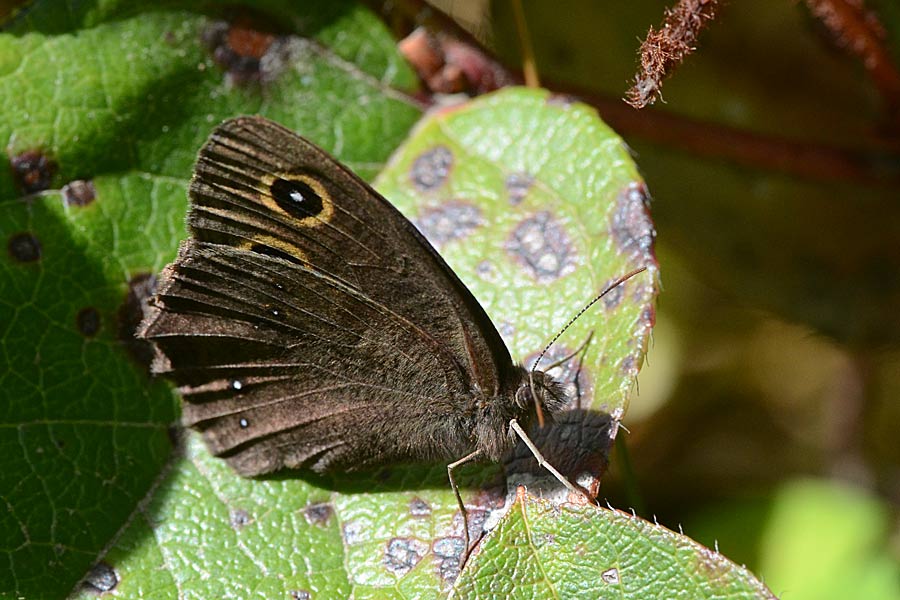
Our first stop was right at the beginning of the Mt. Washington road. A patch of yellow flowers at the entrance of a gated logging road caught my attention. As soon as I exited the car I spotted some Woodland Skippers. A few minutes later my wife announced that she had spotted a large dark butterfly. I saw it basking on a leaf - it was a first of the year (FOY) Common Woodnymph - about 2 weeks earlier than usual. As I approached, it flew but only a short distance which confirmed that it was still warming up to get full circulation into its wings. Before we left that location we saw 3 more.
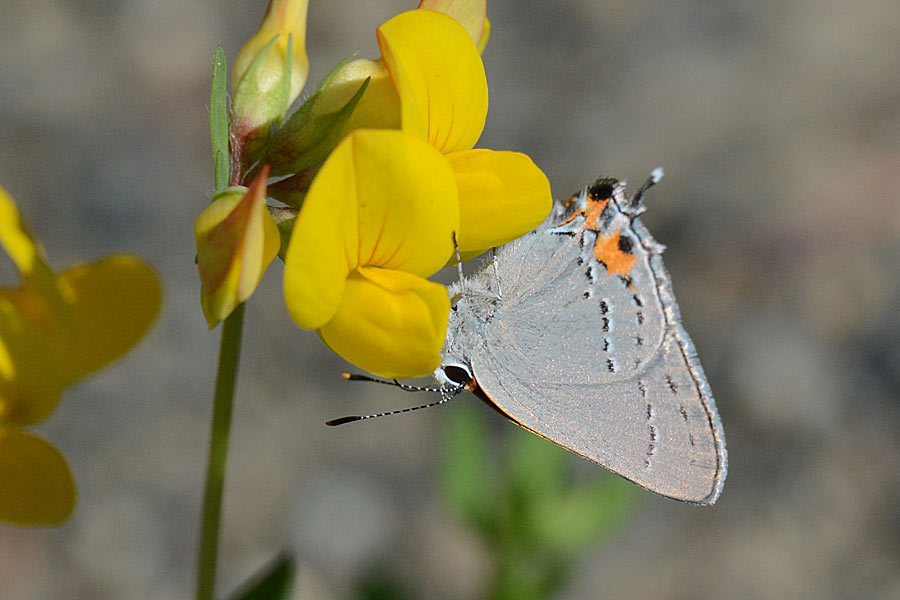
The park and ride parking lot was our next stop. Several groups parked around the lot limited the area we checked, but we found several Woodland Skippers and a small dark butterfly. Closer examination revealed a Gray Hairstreak that was very obliging as it nectared on bird'sfoot trefoil. We saw several more at our next two stops before we reached the higher elevations. All were in good condition and probably second generation.
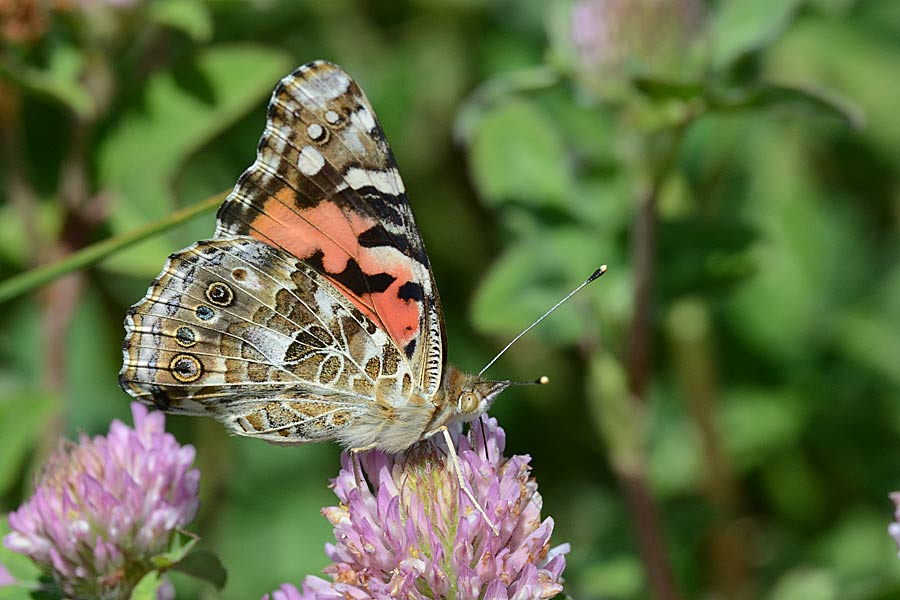
A large patch of trefoil attracted us for our next stop, and we were rewarded by a Painted Lady in prime condition and several more Gray Gairstreaks. In the course of trying to get some good photos we flushed the lady several times, but it wasn't about to leave the patch of flowers. It soon realized we weren't giving up and weren't a threat so it settled down on a flower and allowed us to we got all the shots we wanted.

We made several more stops before the downhill lodge, and every stop produced at least one new species. Before we reached the Raven Lodge we were up to 13 species and our list included Hydaspe Fritillary, Lorquin's Admiral, Clodius Apollo, Common Branded Skipper, Mariposa Copper, Purplish Copper, and Silvery Blue.

When we reached the downhill lodge we decided to ride the lift to the top. Despite the higher elevation the temperature wasn't any cooler. However, we did find 2 of the expected species - many Hydaspe Fritillaries and a few Great Arctics. As expected the Great Arctics were quite faded and nearing the end of their short existence.
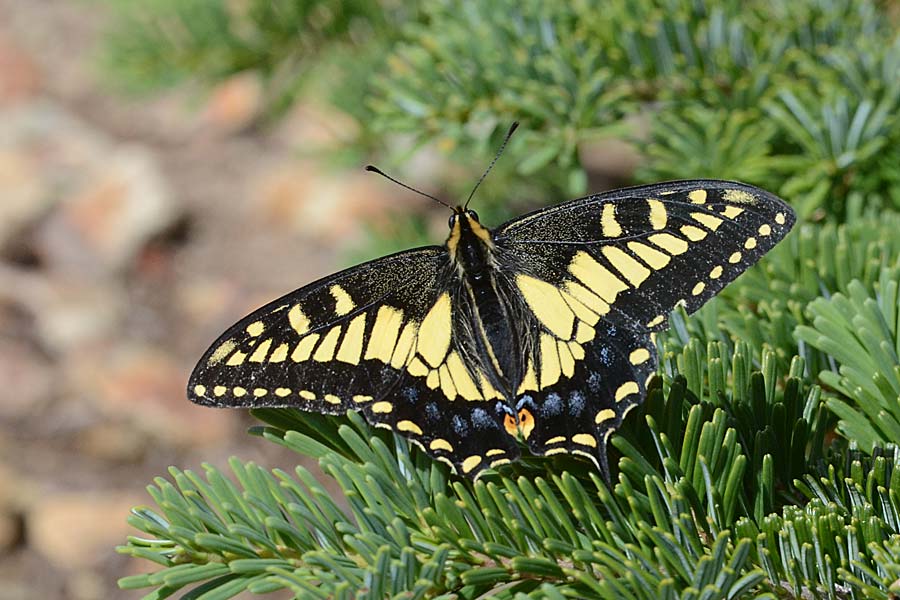
It wasn't too surprising, but it was a pleasure to see a mint conditioned Anise Swallowtail at the peak which suggested recent emergence from the pupa. Species that were possible AWOL included Milbert's Tortoiseshell and Zephyr Comma. Also AWOL from the lift route were the marmots.

Because of the heat we didn't spend much time at the summit, but we when we descended we enjoyed a challenging hour trying to photograph Common Branded Skippers at the base of the ski hil. They were quite abundant but very hyperactive which made them a challenge to photograph. However, patience and persistence was rewarded with a couple of acceptable shots.
WHISTLER RENDEZVOUS
Despite the expenses involved with the ferry and lift, we decided to treat ourselves to the Whistler butterflies. I had enjoyed our two visits in the past two years and wanted to try for some better butterfly photos and look for some new species. In particular, I wanted another opportunity with the Melissa Arctic and Lustrous Copper.

The line-up for lift tickets was agonizingly slow in the stifling Whistler heat, but finally, after an hour, we were on our way to the top. Like everywhere else, it was an early summer and very little snow remained on Whistler peak. But, there was still enough to produce a bubbling stream at the base of the Peak Express.

At the peak I was only 20 m from the lift when I spotted two brightly coloured butterflies - a Mormon Fritillary and Lustrous Copper. I had seen Mormons at lower levels two years ago but never at the peak.

I saw several Mormons and most were content to nectar while I took the photos.

The lustrous Coppers were almost as obliging. They did pose nicely for me, but when my wife tried for some shots, they flew.

It was interesting to see the Lustrous for the second year in a row. According to Dave N. they only appear every second year in Washington.

Our timing was excellent for the Chalcedon Checkerspots. They were abundand and mostly in good condition. There were a few that were quite faded and tattered which meant that they had emerged several weeks ago.

A small grayish blue butterfly proved to be very elusive. When I finally caught one resting I was pleased to see it was an Arctic Blue. My only other experience with the Arctic Blue was last year on Mt. Cokely where I was only able to get a few distant shots. i was happy to add a few closer shots to my collection.
Our time on Whistler was too sort, but we were delighted in the species we saw and the photo opportunities presented. It was a good way to end my butterfly season.
CONQUEST COMPLETED
Eurasian Collared-Doves have conquered Vancouver Island. Slowly but surely under the cover of suburban forests and backyard trees they have prospered and multiplied. They are now one of the most abundant birds on the island and it is estimated that they control 90% of the air space. It is a classic case of conquest by population, and it isn't over yet. So far I've only heard the occasional complaint about them monopolizing backyard feeders. Time will tell if there is cause for concern.

The collared doves can be seen almost everywhere you go on Vancouver Island. This one was at the French Creek estuary.

Tree top visitor - Some loud chirping greeted me when I stepped outside on the morning of July 30. I quickly set up my camera and was delighted to see an Olive-sided Flycatcher on the top of a tall fir. It flew to another tree top slightly closer but still about 70 m away. I was happy to take a few shots just to document its presence even though it was too far for a decent shot. A few seconds later a Cooper's Hawk made a half-hearted pass at it and sent it merrily on its way to Central or South America.
SHOREBIRD MIGRATION
I haven't had the chance to chase the shorebirds reported around the island recently, but it would have been fun to see the Stilt down at Witty's Lagoon and/or the Long Bill Curlew in Tofino. However, I'm paying for the 12 years of neglected chores while I was chasing birds and then butterflies from 2003 to 2015. If doing chores gets me close to a birding location I will sometimes allow myself a treat and toss in the camera. Such was the situation on July 4 when I had to go to Home hardware for some plumbing supplies. Since the store was only a half kilometer from Admiral's Lagoon, the camera got to go for a ride. Of course, I made sure it was high tide before I made the trip as that is the best time to see shorebirds if they are around.
I didn't see any shorebirds around the lagoon when I arrived, but I was in luck just around the corner north of the lagoon. A flock of 40 peeps were working the tideline. They would follow the tideline out as the waves receded and scurry back to the high tide line as the waves pushed in. At first glance they were all Western Sandpipers, but eventually I was able to single out a couple of Least and one Semipalmated. Semipalmated is quite scarce on the west coast so it's always a treat to find one. As expected, all the peeps were juveniles. Typically, the parents abandon the young and migrate earlier.

As expected, most of the sandpipers were Westerns. They can be identified by their longish down-curved bills and the line of rufous colouring along their upper scapulars.
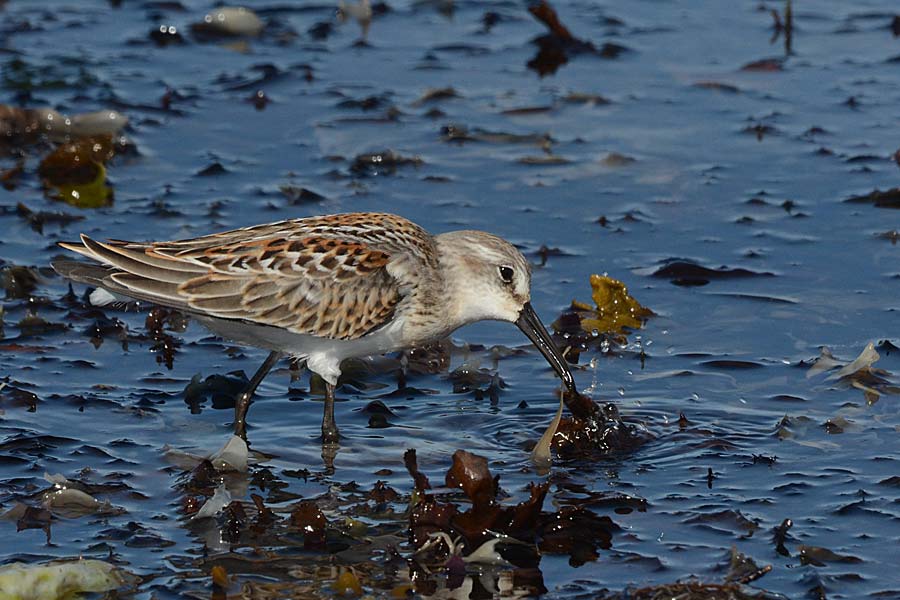
Their bills are extremely adept at catching small aquatic insects.
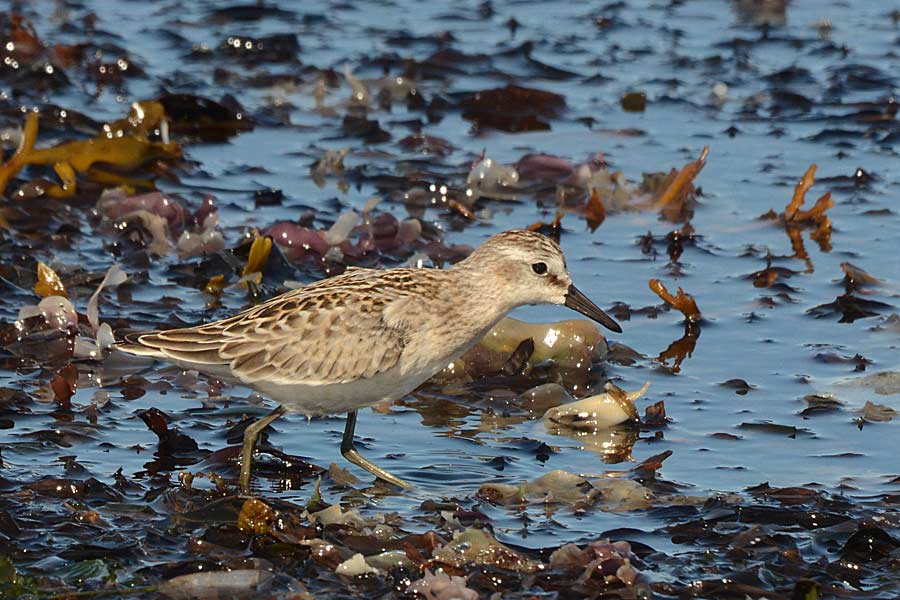
Notice the shorter bill and pale orange on the scapulars. This is a Semipalmated Sandpiper. Another feature is the greenish gray legs. The Westerns have grayish black legs.

In general, the Western is usually larger than the Semipalmated.

The Semipalmated Sandpiper winters around the Caribbean and the coastal areas of northern South America.

Last and Least - The third member of the peep group was the Least Sandpiper. It is appropriately named as it is the smallest of the three species.

There is no mistaking the Least because it has yellow legs.

I found a small group of peeps at French Creek. Most of them flew as soon as the Killdeer gave the warning, but a lone peep stayed. It was a the last and Least.
*********************************************************************************************

*********************************************************************************************
Bird Poster
My poster is on display at: Victoria - Swan Lake Nature House. (Note: This poster has been produced in a more manageable size and is now available for $20 unlaminated and $32 laminated.)

*********************************************************************************************
PUBLICATIONS




